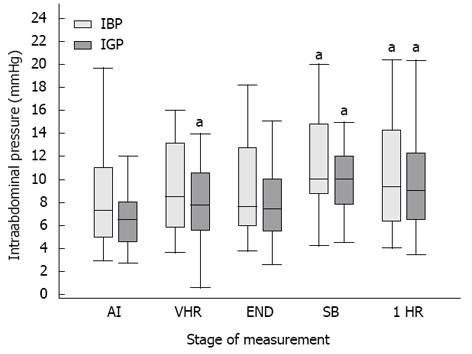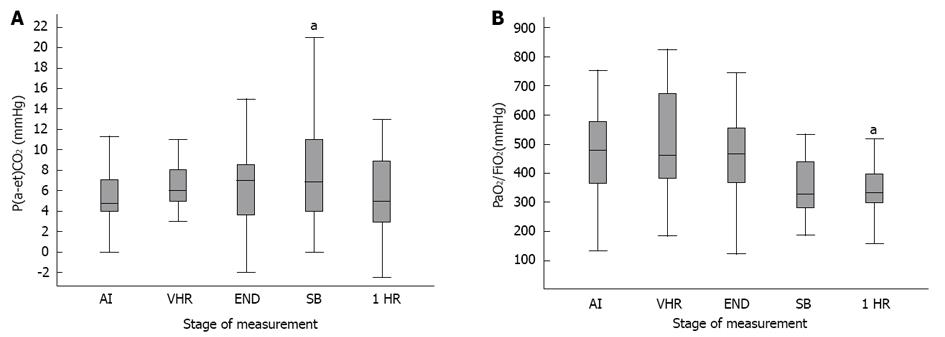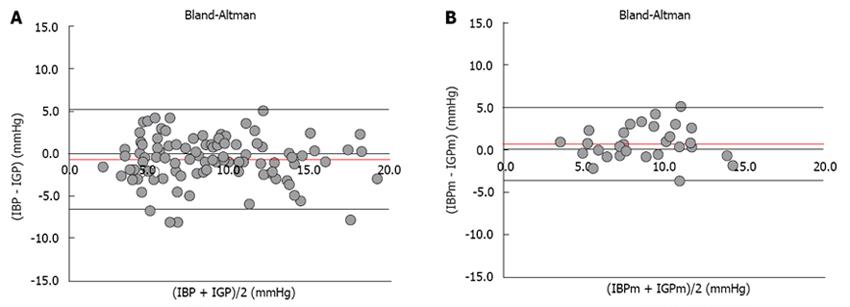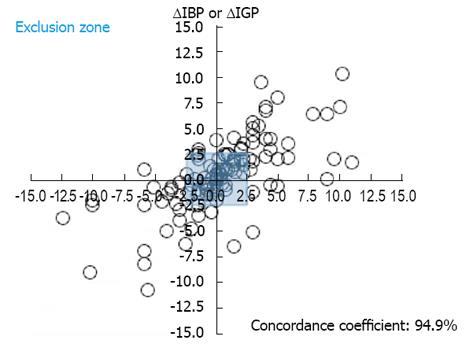Copyright
©2013 Baishideng Publishing Group Co.
World J Crit Care Med. May 4, 2013; 2(2): 9-16
Published online May 4, 2013. doi: 10.5492/wjccm.v2.i2.9
Published online May 4, 2013. doi: 10.5492/wjccm.v2.i2.9
Figure 1 Changes in inintra-abdominal pressure in ventral hernia repair: both methods of measurement are presented.
aP < 0.05 vs after tracheal intubation (AI) values using Wilcoxon’s signed-rank test with Bonferroni correction. Box plots present median, interquartile interval, and minimum–maximum. VHR: After ventral hernia repair; END: End of surgery; SB: During spontaneous breathing through the endotracheal tube; 1 HR: One hour after extubation; IBP: Intrabladder pressure; IGP: Intragastric pressure.
Figure 2 Changes in arterial to end-tidal CO2 gradient (A) and oxygenation index (PaO2/FiO2) (B) during and after ventral hernia repair.
aP < 0.05 vs after tracheal intubation (AI), Wilcoxon’s signed-rank test. Box plots present median, interquartile interval, and minimum-maximum. VHR: After ventral hernia repair; END: End of surgery; SB: During spontaneous breathing through the endotracheal tube; 1 HR: One hour after extubation.
Figure 3 Regression analysis of intrabladder and intragastric pressure.
Patient averages (n = 30) with mean ± SD deviation of intrabladder pressur (IBP) and intragastric pressure (IGP).
Figure 4 Bland-Altman analysis of all paired measurements (n = 128, A) and of paired measurements of mean intrabladder pressure and mean intragastric pressure (n = 30, B).
IBP: Intrabladder pressure; IGP: Intragastric pressure; IBPm: Mean intrabladder pressure; IGPm: Mean Intragastric pressure.
Figure 5 Four quadrants trend plot.
Plot for 117 paired measurements of ΔIBP and ΔIGP. From the 117 initial paired measurements, 55 pairs were excluded because either ΔIBP or ΔIGP were ≤± 2.5 mmHg or because ΔIBP or ΔIGP was equal to zero (exclusion zone). The calculated level of concordance was 94.9%. See text for explanation. IBP: Intrabladder pressure; IGP: Intragastric pressure.
- Citation: Gaidukov KM, Raibuzhis EN, Hussain A, Teterin AY, Smetkin AA, Kuzkov VV, Malbrain ML, Kirov MY. Effect of intra-abdominal pressure on respiratory function in patients undergoing ventral hernia repair. World J Crit Care Med 2013; 2(2): 9-16
- URL: https://www.wjgnet.com/2220-3141/full/v2/i2/9.htm
- DOI: https://dx.doi.org/10.5492/wjccm.v2.i2.9













